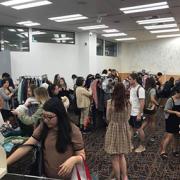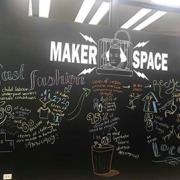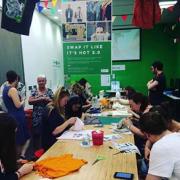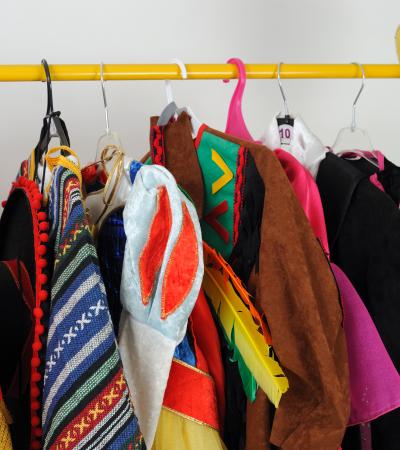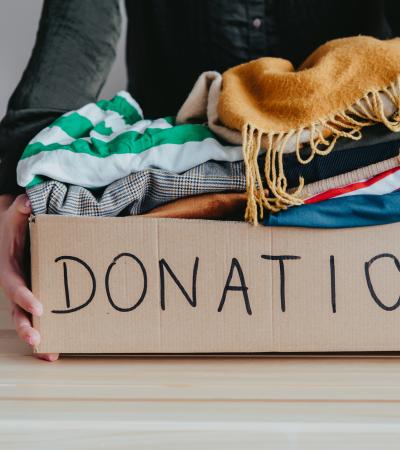Swap It Like It’s Hot is a free clothes-swap program aimed at adult patrons. Patrons bring along their gently-used clothing and receive tokens. They use their tokens to swap for others' items. All remaining clothes after the swap are donated to the city mission.
The library also offered sewing and upcycling workshops in collaboration with Conscious Layers, a local organization that works to popularize the re-use of fashion.
Advanced Planning
The goal of this program was to promote our makerspace through sewing and upcycling workshops running in conjunction with the clothes swap, and to attract millennials to the library in a way that connects with their wants and needs.
We started planning three months in advance to give ample time for promotion. We reached far and wide with our marketing, sending information to at least 10 local event websites and printing around 1,000 fliers to be dropped off at local cafes, hostels, universities and op (thrift) shops.
Conscious Layers donated their time and expertise to us. Working with them, we created a series of workshops that were simple yet pertained to needs in the community. For example, we sewed tote bags since plastic bags are being phased out in New Zealand.
We also used this as an opportunity to expand our email newsletter database by running a small competition to gain feedback and sign-ups to the newsletter.
Marketing
Most of our audience found the event through Facebook, which had 1,600 people "interested." We created the Facebook event two months in advance and linked to it across our library social media channels. We also promoted our event through specific event websites and dropped off fliers around the community.
Budgeting
We had a small budget. We originally aimed to spend money on Facebook advertising, as we had done for our previous clothes swap; however, the interest on Facebook grew organically.
We spent a small amount on clothes racks and hangers to give our event a professional look. We also borrowed clothes racks, hangers and mirrors from our colleagues.
Day-of-event Activity
In total, we had 12 people working the event, a mixture of staff and volunteers. We used our event space and set up clothes on both racks and tables.
Patrons could drop off their clothes starting at 10 a.m., which gave us time to set up and ensured quicker entry for them into the swap. They could then attend the makerspace workshops, which were offered at 11 a.m., 12 p.m. and 2 p.m..
We spent time ensuring that the patron flow through the space was smooth and easy to see. We also had clear signage for various areas and workshops with the relevant information.
The clothes swap itself ran from 1 to 3 p.m. We were overwhelmed by the crowd — 500 came for the swap and 80 attended the sewing workshops. We had a staff member manage the crowd, only letting in around 50 at a time into the swap. We placed spare staff on the clothes drop-off and sorting areas to try process them as fast as possible.
Program Execution
We were ecstatic with the turnout of around 500 people, which meant we had 30 bags of clothes leftover to donate to charity. We also had high attendance and interest in our makerspace offering, which will ideally turn into patrons returning to use our sewing resources.
Around 110 people signed up for our events newsletter, which put them in a drawing to win raffle prizes donated from local businesses. The clothes swap was great for families to refresh their wardrobes, appealed to students with limited funds, and was well attended by the rough-sleeping community.
We asked via Facebook for people to fill in an evaluation survey for us, which gained 41 responses. In general people loved that the event was free and that remaining goods were donated to charity, with almost half of respondents traveling to attend the event. However, they felt that the event was rushed due to the amount of people, and we needed more staff sorting the clothes. We agree with this feedback, and in future have decided to limit each patron’s clothes donation to 10 items each. This would limit the sheer amount of clothes and would ideally improve the quality of donations.
Advice
We would recommend connecting with your community prior to the event to find out their needs and then codesign the event from there. We had a few pilot clothes swaps, run by community organizations, to test out the idea before running with our own event. This allowed us to identify the best way we could deliver the event.
We spent a lot of time chatting with locals in businesses and cafes, as well as online, both to promote the event and to hear their feedback. Our biggest strength was being able to work with our community to deliver the event, from the volunteers helping out, community groups presenting workshops, our local city mission accepting clothes, and having our wider council family supporting through information on how people could be more sustainable and create less waste. This meant that we could provide a full experience for those who attended, addressing the wider issues around sustainability as well as being able to refresh your wardrobe.

